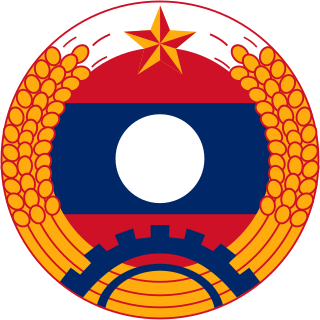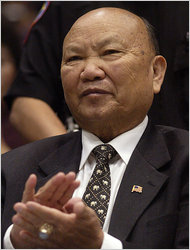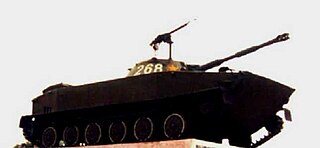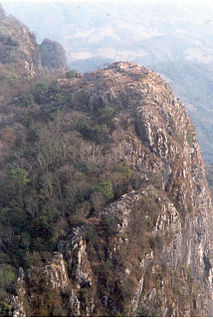This article does not cite any sources .(March 2015) (Learn how and when to remove this template message) |
| |||||
| Decades: | |||||
|---|---|---|---|---|---|
| See also: | Other events of 1968 List of years in Laos | ||||
The following lists events that happened during 1968 in Laos .
This article does not cite any sources .(March 2015) (Learn how and when to remove this template message) |
| |||||
| Decades: | |||||
|---|---|---|---|---|---|
| See also: | Other events of 1968 List of years in Laos | ||||
The following lists events that happened during 1968 in Laos .

Laos, officially the Lao People's Democratic Republic, is a socialist state and the only landlocked country in Southeast Asia. At the heart of the Indochinese Peninsula, Laos is bordered by Myanmar and China to the northwest, Vietnam to the east, Cambodia to the southeast and Thailand to the west and southwest.

The Lao People's Armed Forces (LPAF) is the name of the armed forces of the Lao People's Democratic Republic and the institution of the Lao People's Revolutionary Party, who are charged with protecting the country.

The People's Army of Vietnam, also known as the Vietnamese People's Army (VPA), is the military force of the Socialist Republic of Vietnam. The PAVN is a part of the Vietnam People's Armed Forces and includes: Ground Force, Navy, Air Force, Border Defence Force, Coast Guard, Cyberspace Operations, and Mausoleum Defence Force. However, Vietnam does not have a separate Ground Force or Army branch. All ground troops, army corps, military districts and specialised arms belong to the Ministry of Defence, directly under the command of the Central Military Commission, the Minister of Defence, and the General Staff of the Vietnam People's Army. The military flag of the PAVN is the flag of the Socialist Republic of Vietnam, with the words Quyết thắng added in yellow at the top left.

Việt Minh was a national independence coalition formed at Pác Bó by Hồ Chí Minh on May 19, 1941. The Việt Nam Độc Lập Đồng Minh Hội had previously formed in Nanjing, China, at some point between August 1935 and early 1936 when Vietnamese nationalist parties formed an anti-imperialist united front. This organization soon lapsed into inactivity, only to be revived by the Indochinese Communist Party (ICP) and Hồ Chí Minh in 1941. The Việt Minh established itself as the only organized anti-French and anti-Japanese resistance group. The Việt Minh initially formed to seek independence for Vietnam from the French Empire. The United States supported France. When the Japanese occupation began, the Việt Minh opposed Japan with support from the United States and the Republic of China. After World War II, the Việt Minh opposed the re-occupation of Vietnam by France, resulting in the Indochina War, and later opposed South Vietnam and the United States in the Vietnam War. The political leader and founder of Việt Minh was Hồ Chí Minh. The military leadership was under the command of Võ Nguyên Giáp. Other founders were Lê Duẩn and Phạm Văn Đồng.

The Pathet Lao was a communist political movement and organization in Laos, formed in the mid-20th century. The group was ultimately successful in assuming political power in 1975, after the Laotian Civil War. The Pathet Lao were always closely associated with Vietnamese communists. During the civil war, it was effectively organized, equipped and even led by the People's Army of Vietnam (PAVN). They fought against the anti-communist forces in the Vietnam War. Eventually, the term became the generic name for Laotian communists.

Vang Pao was a major general in the Royal Lao Army. He was a leader in the Hmong American community in the United States.

The Laotian Civil War (1959–1975) was a civil war in Laos fought between the Communist Pathet Lao and the Royal Lao Government from 23 May 1959 to 2 December 1975. It is associated with the Cambodian Civil War and the Vietnam War, with both sides receiving heavy external support in a proxy war between the global Cold War superpowers. It is called the Secret War among the CIA Special Activities Center and Hmong veterans of the conflict.

Air America was an American passenger and cargo airline established in 1946 and covertly owned and operated by the Central Intelligence Agency (CIA) from 1950 to 1976. It supplied and supported covert operations in Southeast Asia during the Vietnam War.

The Battle of Khe Sanh was conducted in the Khe Sanh area of northwestern Quảng Trị Province, Republic of Vietnam, during the Vietnam War. The main US forces defending Khe Sanh Combat Base (KSCB) were two regiments of the United States Marine Corps supported by elements from the United States Army and the United States Air Force (USAF), as well as a small number of Army of the Republic of Vietnam (ARVN) troops. These were pitted against two to three divisional-size elements of the North Vietnamese People's Army of Vietnam (PAVN).

The Battle of Lang Vei began on the evening of 6 February 1968 and concluded during the early hours of 7 February, in Quảng Trị Province, South Vietnam. Towards the end of 1967 the 198th Tank Battalion, People's Army of Vietnam (PAVN) 202nd Armored Regiment, received instructions from the North Vietnamese Ministry of Defense to reinforce the 304th Division as part of the "Route 9-Khe Sanh Campaign". After an arduous journey down the Ho Chi Minh trail in January 1968, the 198th Tank Battalion linked up with the 304th Division for an offensive along Highway 9, which stretched from the Laotian border through to Quảng Trị Province. On 23 January, the 24th Regiment attacked the small Laotian outpost at Bane Houei Sane, under the control of the Royal Laos Army BV-33 "Elephant" Battalion.

Luang Namtha is a district as well as the capital of Luang Namtha Province in northern Laos. The city lies on the Tha River.

Operation Lam Son 719 or 9th Route - Southern Laos Campaign was a limited-objective offensive campaign conducted in the southeastern portion of the Kingdom of Laos. The campaign was carried out by the armed forces of the Republic of Vietnam between 8 February and 25 March 1971, during the Vietnam War. The United States provided logistical, aerial, and artillery support to the operation, but its ground forces were prohibited by law from entering Laotian territory. The objective of the campaign was the disruption of a possible future offensive by the People's Army of Vietnam (PAVN), whose logistical system within Laos was known as the Ho Chi Minh Trail.

The Battle of Lima Site 85, also called Battle of Phou Pha Thi, was fought as part of a military campaign waged during the Vietnam War and Laotian Civil War by the North Vietnamese People's Army of Vietnam (PAVN) and the Pathet Lao, against airmen of the United States Air Force (USAF)'s 1st Combat Evaluation Group, elements of the Royal Lao Army, Royal Thai Border Patrol Police, and the Central Intelligence Agency-led Hmong Clandestine Army. The battle was fought on Phou Pha Thi mountain in Houaphanh Province, Laos, on 10 March 1968, and derives its name from the mountaintop where it was fought or from the designation of a 700 feet (210 m) landing strip in the valley below, and was the largest single ground combat loss of United States Air Force members during the Vietnam War.
The Battle of Ban Houei Sane was a battle of the Vietnam War that began on the night of 23 January 1968, when the 24th Regiment of the People's Army of Vietnam (PAVN) 304th Division overran the small Royal Lao Army outpost at Ban Houei Sane. The fighting at Ban Houei Sane was one in a series of battles fought between North Vietnamese and Allied forces during the Tet Offensive. The small outpost, defended by the 700 man Bataillon Volontaire (BV-33), was attacked and overwhelmed by the vastly superior PAVN and their PT-76 light tanks. The failure of BV-33 to defend their outpost at Ban Houei Sane would have negative consequences only a few weeks later, when the PAVN would strike again at Lang Vei.
The Battle of Luang Namtha, fought between January 1962 and May 1963, was an important engagement of the Laotian Civil War. It came about as a result of the turmoil following Laotian independence as a result of the First Indochina War with France. The Kingdom of Laos had foreign soldiers upon its soil, and a political struggle in progress concerning those outside troops. Following a coup and counter-coup that left General Phoumi Nosavan in charge, the general decided on military action to settle the political issue of interlopers in Laos.
The Battle of Lak Sao, fought between November 1963 and January 1964, was a major engagement of the Laotian Civil War. In November 1963, General Phoumi Nosavan, who held the reins of military power in the Kingdom of Laos, launched a military offensive against North Vietnamese invaders that cut across the northern panhandle of the nation. Although unsupported in this proxy action by his backers in the U.S. Embassy, he went ahead with his plan to push northwards from Nhommarath, then veer eastwards to the Vietnamese border. Phoumi's Central Intelligence Agency (CIA) advisors warned him that the North Vietnamese would retaliate, but he disregarded them.
The Battle of Vientiane was the decisive action of the 1960 Laotian coups. Fought between 13 and 16 December 1960, the battle ended with General Phoumi Nosavan winning control of the Kingdom of Laos with the aid of the Royal Thai Government and the U.S. Central Intelligence Agency. Vientiane was left devastated by the fighting, with about 600 civilian dead, about the same number of homes destroyed, and 7,000 left homeless. The losing Forces Armées Neutralistes under Captain Kong Le retreated onto the strategic Plain of Jars, to begin an uneasy coexistence with the Pathet Lao and the invading People's Army of Vietnam.
The following lists events that happened during 1960 in Laos.
The following lists events that happened during 1961 in Laos.
Cannabis is illegal in Laos but a cannabis culture still exists.
| This article related to the history of Laos or its predecessor states is a stub. You can help Wikipedia by expanding it. |
| This year in Asia article is a stub. You can help Wikipedia by expanding it. |